Tribological Properties of the 40Cr/GCr15 Tribo-Pair under Unidirectional Rotary and Reciprocating Dry Sliding
Abstract
:1. Introduction
2. Materials and Experimental Methods
2.1. Sample Preparation
2.2. Wear Test and Characterization
3. Results and Discussion
3.1. Tribological Performance
3.2. Wear Surface Morphology
3.2.1. Pin Samples
3.2.2. Disc and Flat Samples
3.3. Microstructural Evolution in the Tribo-Layer
3.3.1. Rotary Sliding
3.3.2. Reciprocating Sliding
3.4. Microhardness Gradient
4. Conclusions
Author Contributions
Funding
Institutional Review Board Statement
Informed Consent Statement
Data Availability Statement
Acknowledgments
Conflicts of Interest
References
- Blau, P. The significance and use of the friction coefficient. Tribol. Int. 2001, 34, 585–591. [Google Scholar] [CrossRef]
- Jamari, J.; Ammarullah, M.I.; Saad, A.P.M.; Syahrom, A.; Uddin, M.; van der Heide, E.; Basri, H. The Effect of Bottom Profile Dimples on the Femoral Head on Wear in Metal-on-Metal Total Hip Arthroplasty. J. Funct. Biomater. 2021, 12, 38. [Google Scholar] [CrossRef] [PubMed]
- Ammarullah, M.I.; Afif, I.Y.; Maula, M.I.; Winarni, T.I.; Tauviqirrahman, M.; Akbar, I.; Basri, H.; van der Heide, E.; Jamari, J. Tresca Stress Simulation of Metal-on-Metal Total Hip Arthroplasty during Normal Walking Activity. Materials 2021, 14, 7554. [Google Scholar] [CrossRef] [PubMed]
- Mussa, A.; Krakhmalev, P.; Bergström, J. Sliding wear and fatigue cracking damage mechanisms in reciprocal and unidirectional sliding of high-strength steels in dry contact. Wear 2020, 444–445, 203119. [Google Scholar] [CrossRef]
- Han, J.M.; Zhang, R.; Ajayi, O.O.; Barber, G.C.; Zou, Q.; Guessous, L.; Schall, D.; Alnabulsi, S. Scuffing behavior of gray iron and 1080 steel in reciprocating and rotational sliding. Wear 2010, 271, 1854–1861. [Google Scholar] [CrossRef]
- Cho, D.H.; Lee, Y.Z. Comparison of scuffing life between unidirectional and reciprocating sliding motion. Wear 2011, 271, 1637–1641. [Google Scholar] [CrossRef]
- Cho, D.H.; Kim, J.S.; Jia, J.; Lee, Y.Z. Comparative analysis based on adiabatic shear instability for scuffing failure between unidirectional and reciprocating sliding motion. Wear 2013, 297, 774–780. [Google Scholar] [CrossRef]
- Wu, H.; Li, X.; He, X.; Lu, J.; Wang, L.; Zhou, B.; Dong, G. An investigation on the lubrication mechanism of MoS2 nanoparticles in unidirectional and reciprocating sliding point contact: The flow pattern effect around contact area. Tribol. Int. 2018, 122, 38–45. [Google Scholar] [CrossRef]
- Balarini, R.; Diniz, G.A.S.; Profito, F.J.; Souza, R.M. Comparison of unidirectional and reciprocating tribometers in tests with MoDTC-containing oils under boundary lubrication. Tribol. Int. 2019, 149, 105686. [Google Scholar] [CrossRef]
- Liu, Y.; Chen, L.; Jiang, B.; Liu, Y.; Zhang, B.; Xiao, C.; Zhang, J.; Qian, L. Origin of low friction in hydrogenated diamond-like carbon films due to graphene nanoscroll formation depending on sliding mode: Unidirection and reciprocation. Carbon 2020, 173, 696–704. [Google Scholar] [CrossRef]
- Zhang, Q.; Chen, X.; Han, Z. Subsurface morphological pattern, microstructure and wear response of Cu and Cu–Al alloys subjected to unidirectional and reciprocating sliding. Wear 2020, 462–463, 2023521. [Google Scholar] [CrossRef]
- Podgornik, B.; Vizintin, J.; Ronkainen, H.; Holmberg, K. Friction and wear properties of DLC-coated plasma nitrided steel in unidirectional and reciprocating sliding. Thin Solid Film. 2000, 377, 254–260. [Google Scholar] [CrossRef]
- Jumahat, A.; Talib, A.A.A.; Sharudin, H.; Zulfikli, N.W.M. Tribological behavior of nanoclay-filled basalt fiber-reinforced polymer composites. In Tribology of Polymer Composites; Elsevier: Amsterdam, The Netherlands, 2021; pp. 143–162. [Google Scholar]
- Blau, P.; Walukas, M. Sliding friction and wear of magnesium alloy AZ91D produced by two different methods. Tribol. Int. 2000, 33, 573–579. [Google Scholar] [CrossRef]
- Rigney, D.A.; Divakar, R.; Kuo, S.M. Deformation substructures associated with very large plastic strains. Scr. Metall. Mater. 1992, 27, 975–980. [Google Scholar] [CrossRef]
- Ward, R. A comparison of reciprocating and continuous sliding wear. Wear 1970, 15, 423–434. [Google Scholar] [CrossRef]
- Noboru, Y.; Fusao, H. A Comparison of Wear of Annealed Carbon Steels between Reciprocating Friction and Uni-Directional Friction under Lubrication. Trans. Jpn. Soc. Mech. Eng. Ser. C 1981, 47, 1354–1365. [Google Scholar]
- Hwang, D.H.; Kim, D.E.; Lee, S.J. Influence of wear particle interaction in the sliding interface on friction of metals. Wear 1999, 225–229, 427–439. [Google Scholar] [CrossRef]
- Marui, E.; Endo, H. Effect of reciprocating and unidirectional sliding motion on the friction and wear of copper on steel. Wear 2001, 249, 582–591. [Google Scholar] [CrossRef]
- Zhao, X.; Zhao, B.; Liu, Y.; Cai, Y.; Hu, C. Research on friction and wear behavior of gradient nano-structured 40Cr steel induced by high frequency impacting and rolling. Eng. Fail. Anal. 2017, 83, 167–177. [Google Scholar] [CrossRef]
- Liang, S.; Zhu, P.; Yang, Y.; He, X.; Wei, X. Subsurface Dynamic Deformation and Nano-structural Evolution in 40Cr Steel Under Dry Sliding Wear. Tribol. Lett. 2019, 67, 102. [Google Scholar] [CrossRef]
- Chromik, R.R.; Zhang, Y. Nanomechanical testing of third bodies. Curr. Opin. Solid State Mater. Sci. 2018, 22, 144–155. [Google Scholar] [CrossRef]
- Grützmacher, P.G.; Rosenkranz, A.; Rammacher, S.; Gachot, C.; Mücklich, F. The influence of centrifugal forces on friction and wear in rotational sliding. Tribol. Int. 2017, 116, 256–263. [Google Scholar] [CrossRef]
- So, H. Characteristics of wear results tested by pin-on-disc at moderate to high speeds. Tribol. Int. 1996, 29, 415–423. [Google Scholar] [CrossRef]
- Fillot, N.; Iordanoff, I.; Berthier, Y. Wear modeling and the third body concept. Wear 2007, 262, 949–957. [Google Scholar] [CrossRef]
- Young, J.L.; Wilsdorf, K.D.; Hull, R. The generation of mechanically mixed layers (MMLs) during sliding contact and the effects of lubricant thereon. Wear 2000, 246, 74–90. [Google Scholar] [CrossRef]
- Venkataraman, B.; Sundararajan, G. Correlation between the characteristics of the mechanically mixed layer and wear behaviour of aluminium, Al-7075 alloy and Al-MMCs. Wear 2000, 245, 22–38. [Google Scholar] [CrossRef]
- Ghazali, M.J.; Rainforth, W.M.; Omar, M.Z. A comparative study of mechanically mixed layers (MMLs) characteristics of commercial aluminium alloys sliding against alumina and steel sliders. J. Mater. Processing Technol. 2008, 201, 662–668. [Google Scholar] [CrossRef]
- Alsaran, A. Determination of tribological properties of ion-nitrided AISI 5140 steel. Mater. Charact. 2002, 49, 171–176. [Google Scholar] [CrossRef]
- Viáfara, C.C.; Sinatora, A. Influence of hardness of the harder body on wear regime transition in a sliding pair of steels. Wear 2009, 267, 425–432. [Google Scholar] [CrossRef]
- Kolubaev, A.; Tarasov, S.; Sizova, O.; Kolubaev, E. Scale-dependent subsurface deformation of metallic materials in sliding. Tribol. Int. 2010, 43, 695–699. [Google Scholar] [CrossRef]
- Schouwenaars, R.; Jacobo, V.H.; Ortiz, A. Microstructural aspects of wear in soft tribological alloys. Wear 2007, 263, 727–735. [Google Scholar] [CrossRef]
- Tarasov, S.; Rubtsov, V.; Kolubaev, A. Subsurface shear instability and nanostructuring of metals in sliding. Wear 2010, 268, 59–66. [Google Scholar] [CrossRef]
- Yao, B.; Han, Z.; Li, Y.S.; Tao, N.R.; Lu, K. Dry sliding tribological properties of nanostructured copper subjected to dynamic plastic deformation. Wear 2011, 271, 1609–1616. [Google Scholar] [CrossRef]
- Sharkeev, Y.P.; Legostaeva, E.V.; Panin, S.V.; Gritsenko, B.P. Experimental investigation of friction and wear of Mo ion implanted ferritic/pearlitic steel. Surf. Coat. Technol. 2002, 158, 674–679. [Google Scholar] [CrossRef]
- Panin, V.; Kolubaev, A.; Tarasov, S.; Popov, V. Subsurface layer formation during sliding friction. Wear 2001, 249, 860–867. [Google Scholar] [CrossRef]
- Zhu, J.; Ma, L.; Joyce, R.S. Friction and wear of Cu-15wt%Ni-8wt%Sn bronze lubricated by grease at room and elevated temperature. Wear 2020, 460–461, 203474. [Google Scholar] [CrossRef]
- Grützmacher, P.G.; Suarez, S.; Tolosa, A.; Gachot, C.; Song, G.; Wang, B.; Presser, V.; Mücklich, F.; Anasori, B.; Rosenkranz, A. Superior Wear-Resistance of Ti3C2Tx Multilayer Coatings. ACS Nano 2021, 15, 8216–8224. [Google Scholar] [CrossRef]
- Rigney, D.A. Transfer, mixing and associated chemical and mechanical processes during the sliding of ductile materials. Wear 2000, 245, 1–9. [Google Scholar] [CrossRef]
- Bill, R.C.; Wisander, D. Recrystallization as a controlling process in the wear of some F.C.C. metals. Wear 1977, 41, 351–363. [Google Scholar] [CrossRef]
- Karthikeyan, S.; Agrawal, A.; Rigney, D.A. Molecular dynamics simulations of sliding in an Fe–Cu tribopair system. Wear 2009, 267, 1166–1176. [Google Scholar] [CrossRef]
- Rigney, D.A.; Karthikeyan, S. The Evolution of Tribomaterial during Sliding: A Brief Introduction. Tribol. Lett. 2010, 39, 3–7. [Google Scholar] [CrossRef]
- Chen, X.; Han, Z.; Lu, K. Wear mechanism transition dominated by subsurface recrystallization structure in Cu-Al alloys. Wear 2014, 320, 41–50. [Google Scholar] [CrossRef]
- Rosenkranz, A.; Heib, T.; Gachot, C.; Mücklich, F. Oil film lifetime and wear particle analysis of laser-patterned stainless steel surfaces. Wear 2015, 334, 1–12. [Google Scholar] [CrossRef]
- Psakhie, S.G.; Zolnikov, K.P.; Dmitriev, A.I.; Smolin, A.Y.; Shilko, E.V. Dynamic vortex defects in deformed material. Phys. Mesomech. 2014, 17, 15–22. [Google Scholar] [CrossRef]
- Li, C.; Bell, T. Sliding wear properties of active screen plasma nitrided 316 austenitic stainless steel. Wear 2004, 256, 1144–1152. [Google Scholar] [CrossRef]
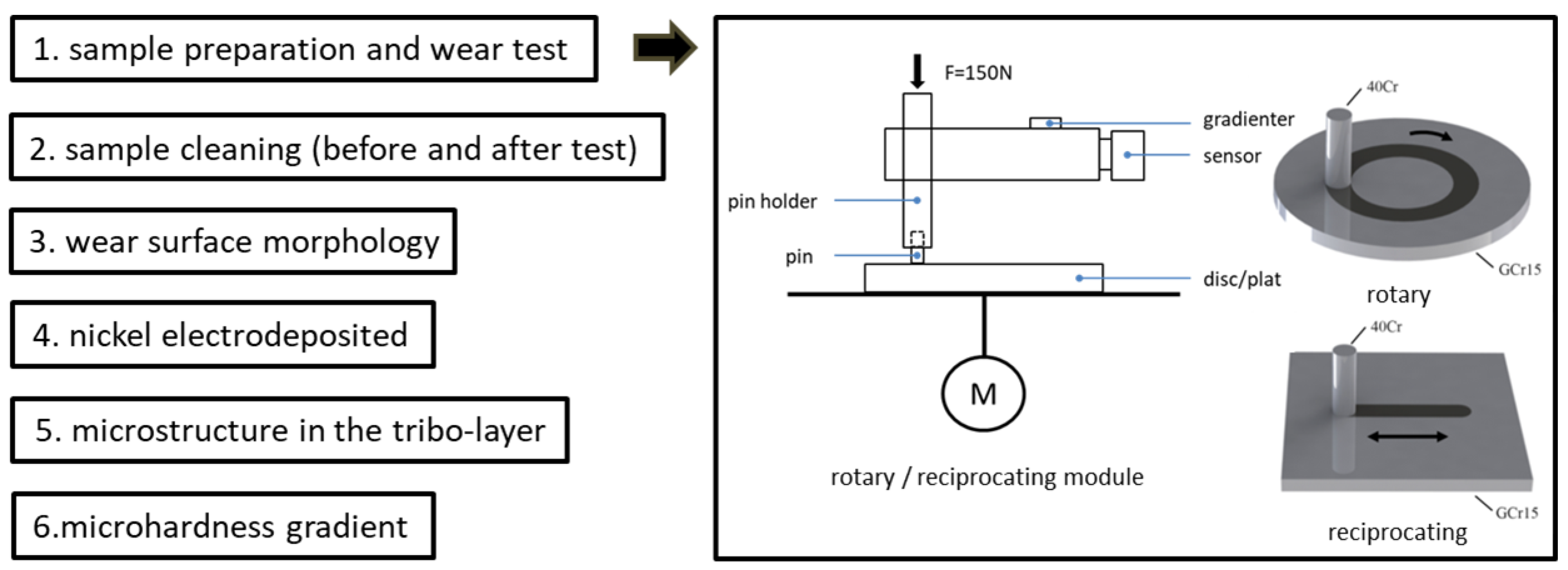
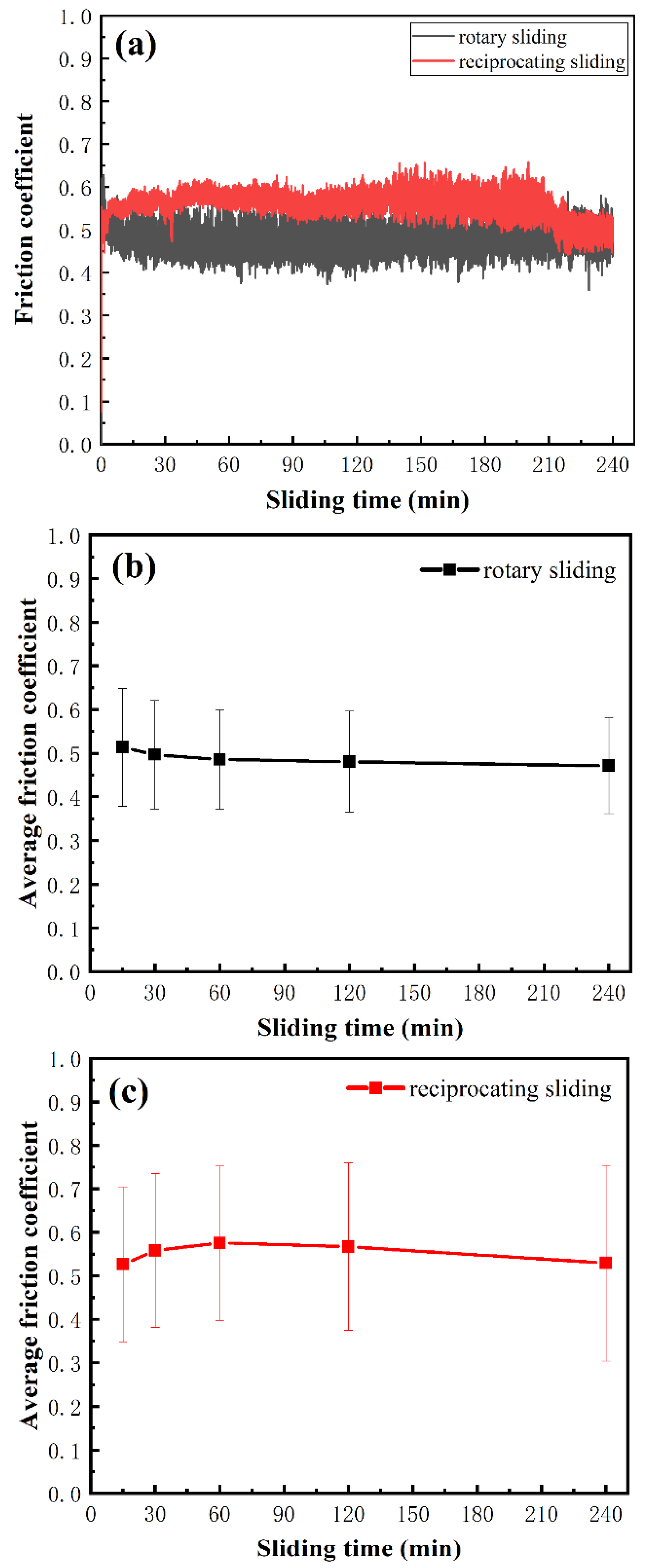
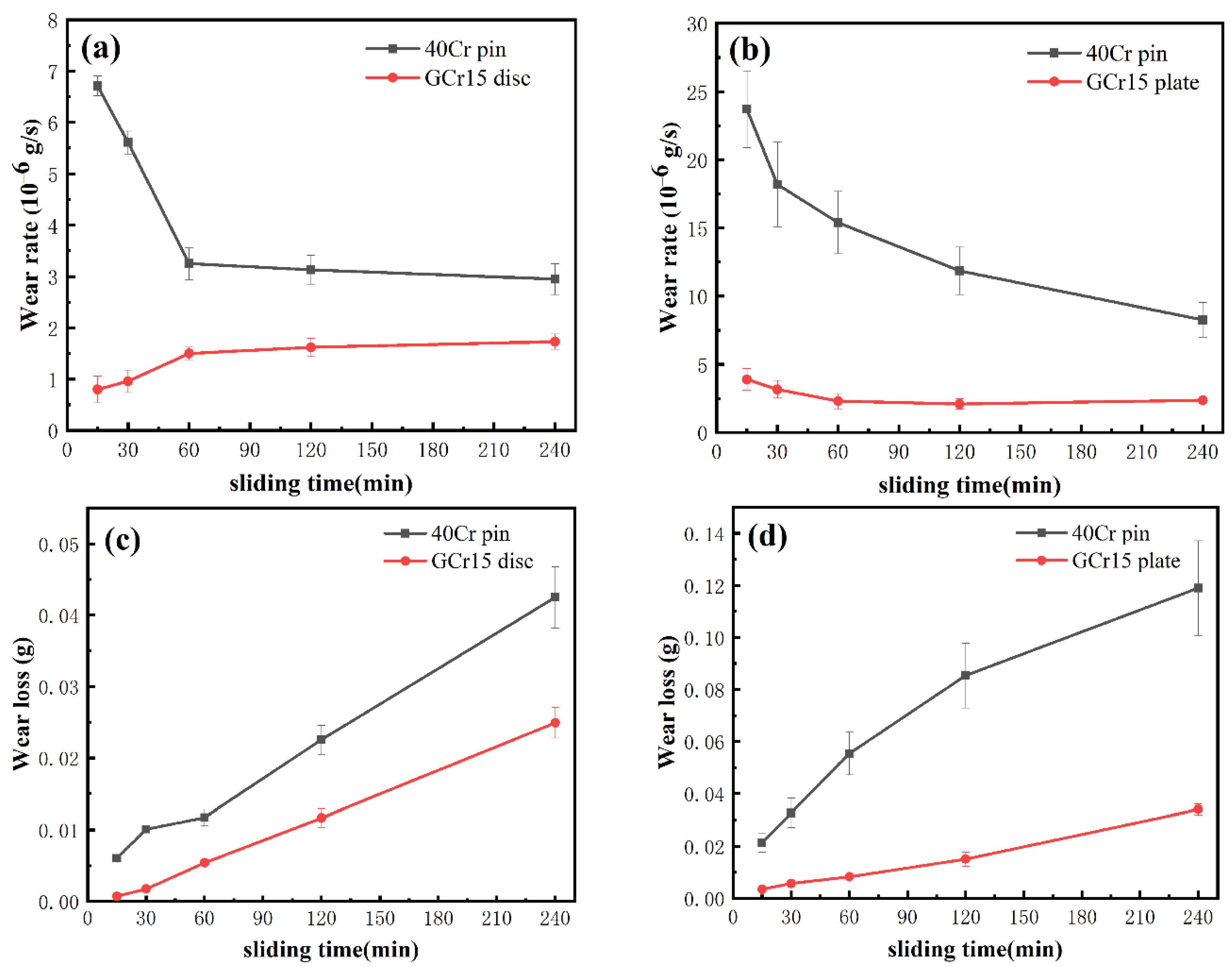
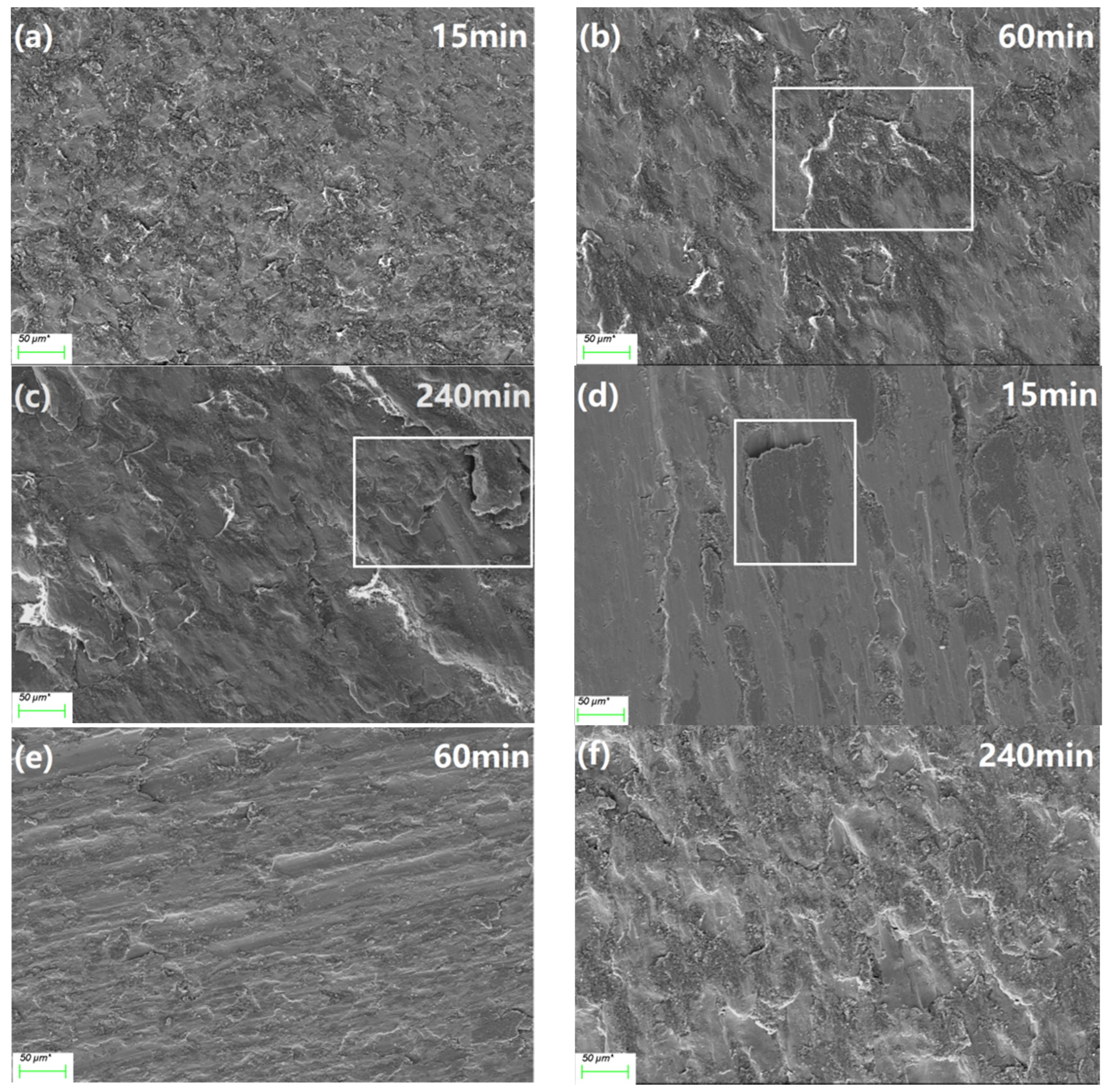


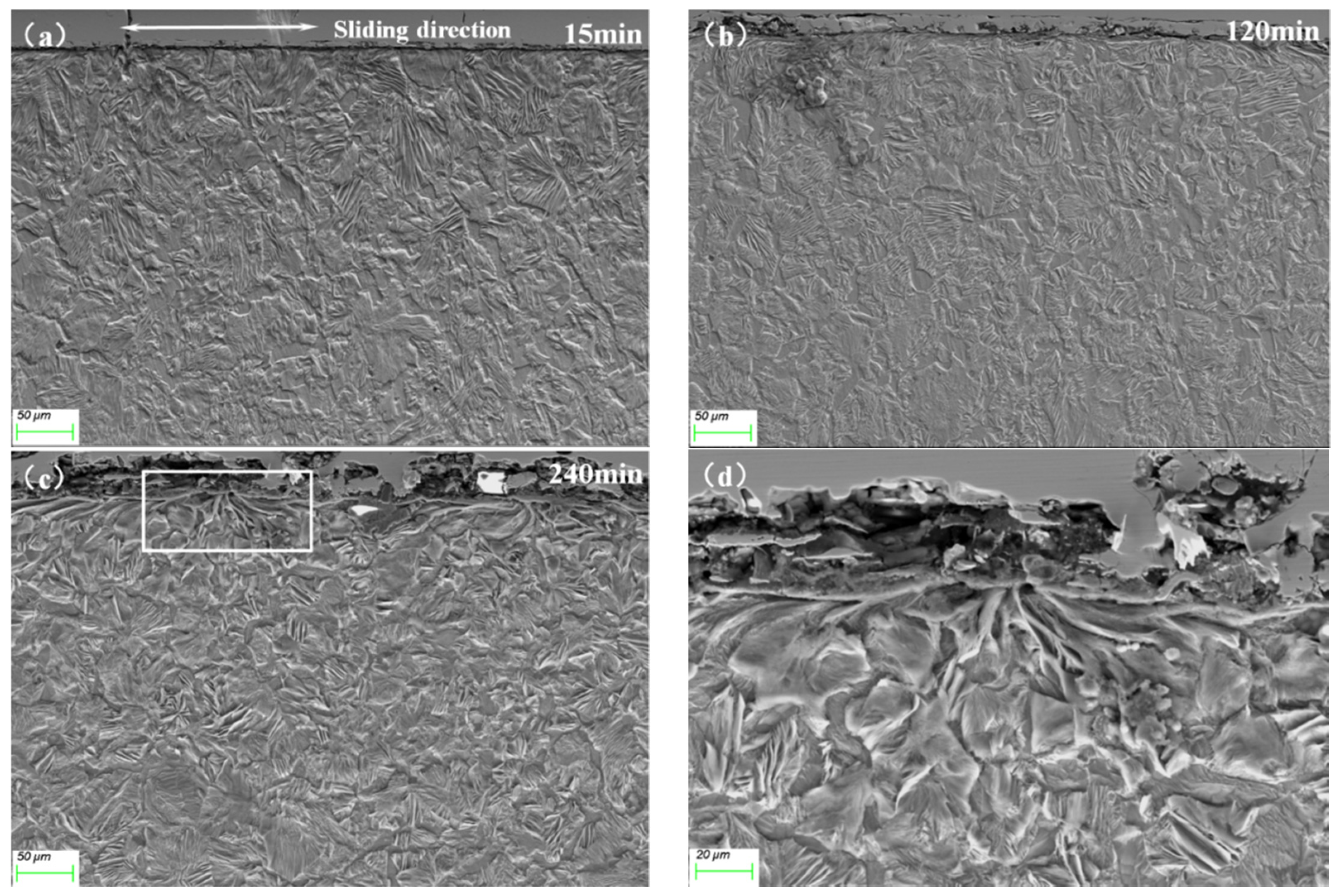

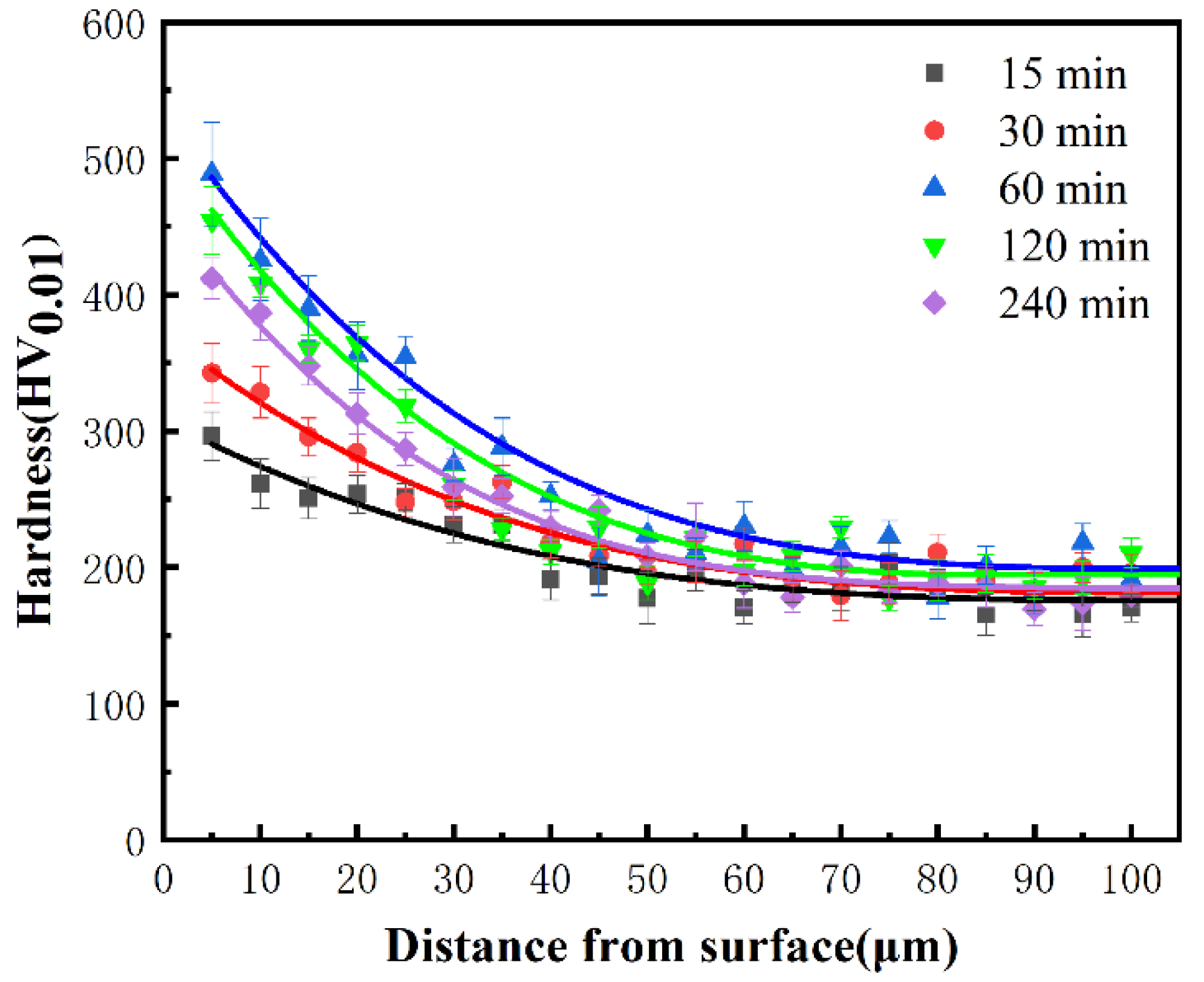


| Material | C | Cr | Mn | Si | Ni | S | P | Fe |
|---|---|---|---|---|---|---|---|---|
| 40Cr | 0.434 | 0.893 | 0.644 | 0.242 | 0.026 | 0.007 | 0.014 | Balance |
| GCr15 | 1.010 | 1.479 | 0.315 | 0.218 | 0.022 | 0.008 | 0.021 | Balance |
| Composition | NiSO4·7H2O | NiCl2 | H3BO3 | NaC12H25SO4 |
|---|---|---|---|---|
| Content | 320 g /L | 45 g/L | 30 g/L | 0.5 g/L |
Publisher’s Note: MDPI stays neutral with regard to jurisdictional claims in published maps and institutional affiliations. |
© 2022 by the authors. Licensee MDPI, Basel, Switzerland. This article is an open access article distributed under the terms and conditions of the Creative Commons Attribution (CC BY) license (https://creativecommons.org/licenses/by/4.0/).
Share and Cite
Cao, J.; Teng, H.; Wang, W.; Wei, X.; Zhao, H. Tribological Properties of the 40Cr/GCr15 Tribo-Pair under Unidirectional Rotary and Reciprocating Dry Sliding. Coatings 2022, 12, 557. https://doi.org/10.3390/coatings12050557
Cao J, Teng H, Wang W, Wei X, Zhao H. Tribological Properties of the 40Cr/GCr15 Tribo-Pair under Unidirectional Rotary and Reciprocating Dry Sliding. Coatings. 2022; 12(5):557. https://doi.org/10.3390/coatings12050557
Chicago/Turabian StyleCao, Jialiang, Huan Teng, Wurong Wang, Xicheng Wei, and Hongshan Zhao. 2022. "Tribological Properties of the 40Cr/GCr15 Tribo-Pair under Unidirectional Rotary and Reciprocating Dry Sliding" Coatings 12, no. 5: 557. https://doi.org/10.3390/coatings12050557
APA StyleCao, J., Teng, H., Wang, W., Wei, X., & Zhao, H. (2022). Tribological Properties of the 40Cr/GCr15 Tribo-Pair under Unidirectional Rotary and Reciprocating Dry Sliding. Coatings, 12(5), 557. https://doi.org/10.3390/coatings12050557






